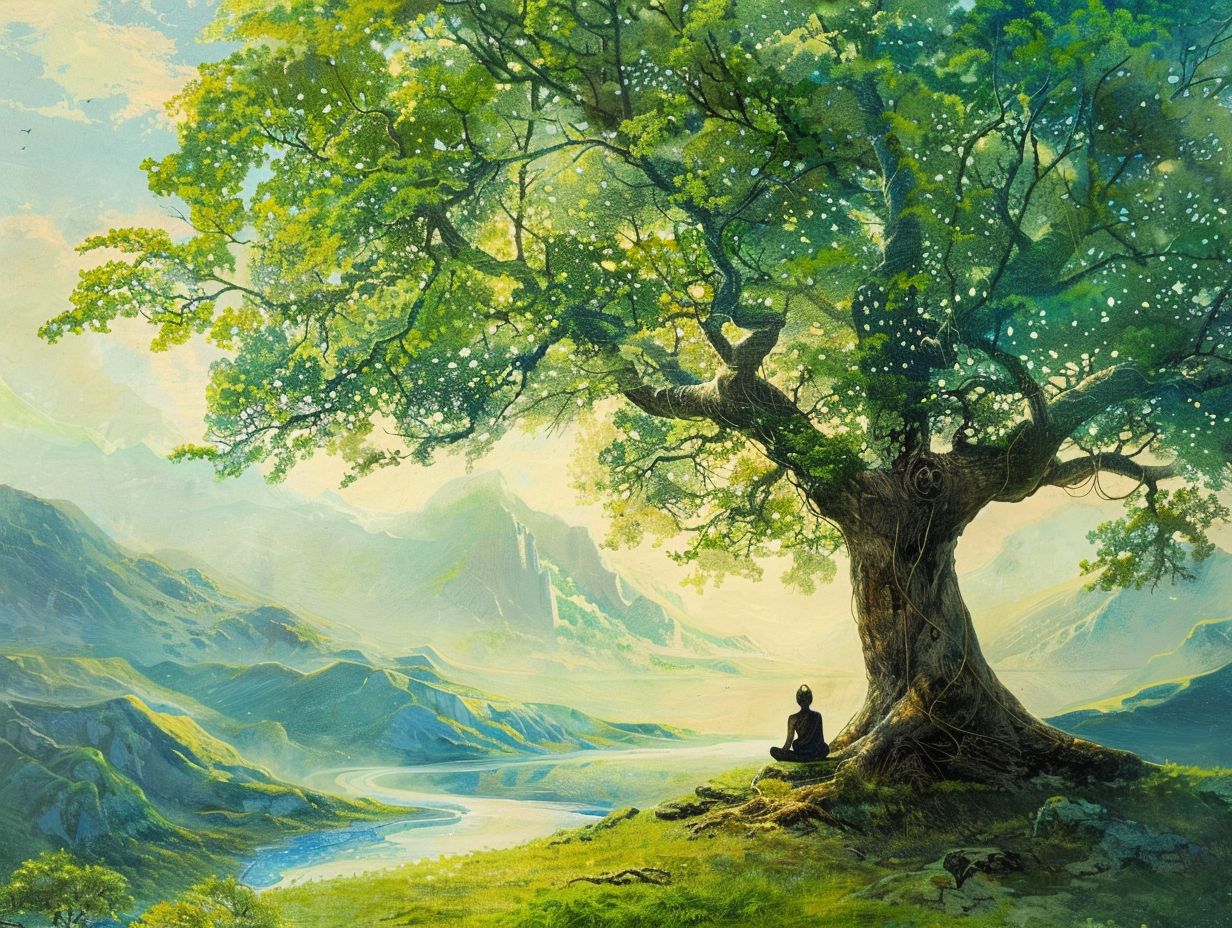The Concepts of Prakriti and Purusha in Samkhya
Samkhya philosophy, revered as one of the most ancient systems of thought in India, unveils profound insights into the nature of existence through its distinctive concepts of Prakriti and Purusha. This exploration offers a deep dive into the essence of Prakriti, elucidating its distinction from Purusha and illuminating the intricate interplay between these two fundamental principles.
The discourse encompasses the three Gunas of Prakriti, the pivotal role of Purusha, and how a nuanced understanding of these concepts can facilitate the journey toward liberation.
Engaging with the practices and challenges inherent in the pursuit of true freedom within the framework of Samkhya philosophy reveals a transformative path for seekers of wisdom and enlightenment.
What is Samkhya Philosophy?

Samkhya philosophy, an esteemed ancient Indian philosophical framework, stands as one of the cornerstones of Indian thought, articulating the dualism between Prakriti (nature) and Purusha (consciousness).
This profound and intricate system, deeply embedded in Vedic texts and rich metaphysical inquiry, endeavors to illuminate the nature of reality, the intricate mind-body relationship, and the ultimate purpose of human existence.
Through a dialectical examination of matter and spirit, it underscores the significance of attaining liberation (moksha) via self-awareness and the thoughtful integration of existential inquiry within the cosmic order. In doing so, Samkhya philosophy presents a comprehensive perspective on both the universe and the human experience.
The Concept of Prakriti in Samkhya
In Samkhya philosophy, Prakriti signifies the primordial essence of reality, encapsulating the material dimensions of the universe and acting as the wellspring of all creation, transformation, and equilibrium among the three gunas tamas, rajas, and sattva that dictate human experience and behavior.
This foundational concept emphasizes the dualism inherent in existence, juxtaposing the dynamic characteristics of the material world with the transcendental nature of Purusha, or consciousness. In doing so, it provides profound insights into the intricate interplay of elements and energies that influence and shape human life.
What is Prakriti?
Prakriti, a fundamental concept within Samkhya philosophy, is elegantly characterized as the material principle of the universe. It embodies the dynamic forces of nature, the cosmic laws that govern existence, and the essential elements that comprise all forms of life and reality.
This notion transcends mere physical manifestations, reaching into the depths of consciousness and shaping how individuals perceive and engage with their surroundings. In various spiritual practices, Prakriti lays the groundwork for comprehending the interconnectedness of all beings and the pivotal role nature plays in molding human experience.
Through contemplation of the relationship between Prakriti and Purusha conscious awareness practitioners uncover profound insights into the equilibrium between the material and spiritual realms. This exploration nurtures a deeper connection to the natural world and cultivates a sense of harmony within oneself.
How is Prakriti Different from Purusha?
Prakriti and Purusha serve as the two foundational principles of Samkhya philosophy, with Prakriti representing the material aspect of existence and the unfolding of nature, while Purusha embodies the unchanging consciousness that transcends physical reality. This transcendence offers the potential for liberation from the relentless cycle of existence.
Understanding this dualistic nature is crucial for grasping the complexities of human experience. Prakriti encompasses all manifestations of the physical world, including the mind and emotions, and drives the evolution and interaction of various life elements.
In stark contrast, Purusha, as pure awareness, remains detached and untouched by the chaos of material existence. The dynamic interplay between these principles enhances comprehension of the mind-body connection, revealing how the fluctuations of the mind emerge from Prakriti.
Meanwhile, the unwavering essence of Purusha inspires individuals to seek greater self-awareness and fulfillment, transcending the limitations imposed by their transient physical forms.
What are the Three Gunas of Prakriti?
The three gunas of Prakriti tamas, rajas, and sattva embody the essential qualities that define all facets of nature. Tamas signifies inertia and darkness, rajas represents activity and passion, while sattva reflects purity and harmony.
These energies transcend mere theoretical concepts; they wield a profound influence over human behavior, shaping thoughts, emotions, and actions in ways that can either elevate or obstruct spiritual growth. Tamas, often linked with lethargy and ignorance, can result in stagnation, whereas rajas drives individuals toward ambition and restlessness. In juxtaposition, sattva nurtures clarity and tranquility, encouraging thoughtful actions and a purposeful existence.
Grasping the interplay of these three gunas is vital for those on a path of personal transformation, as a balanced perspective cultivates a harmonious life. Numerous spiritual practices advocate for the cultivation of sattva through meditation, mindful living, and ethical conduct, illustrating how awareness of these energies can usher in significant shifts in perception and experience.
The Concept of Purusha in Samkhya

In the context of Samkhya philosophy, Purusha is envisioned as the embodiment of pure consciousness, existing beyond the confines of the material realm. This concept represents the ultimate reality and the essence of the self, transcending the dualism presented by Prakriti.
Consequently, Purusha serves as the foundation for spiritual evolution and self-realization in the human experience.
What is Purusha?
Purusha is regarded as the eternal, unchanging consciousness within Samkhya philosophy, embodying the essence of self and serving as the ultimate reality that transcends the material world. This concept reveals the profound influence of spiritual practice and metaphysical ideas on human existence.
The notion of Purusha is not simply a static idea; it encompasses a profound understanding of the self as distinct from the transient phenomena of nature, known as Prakriti. The dynamic interplay between Purusha and Prakriti underscores the duality that characterizes existence, with Purusha acting as the observer and Prakriti manifesting the ever-evolving forms of the material world.
Through meditation and introspection, individuals can connect with the essence of Purusha, enabling them to navigate their spiritual journeys with clarity and purpose. This connection cultivates a deeper understanding of personal identity and situates the self within the vast expanse of existence, thereby making it an integral aspect of broader metaphysical discussions.
How is Purusha Different from Prakriti?
The distinction between Purusha and Prakriti resides in their essential natures; Purusha symbolizes the eternal consciousness that remains unconditioned and transcendent, while Prakriti represents the ever-evolving facets of nature and the material world. This contrast underscores the dualism that forms the foundation of Samkhya philosophy.
This dual nature serves as a vital framework for comprehending the human experience. Here, Purusha embodies the true self, a witness impervious to the vicissitudes of life, while Prakriti encompasses the emotions, thoughts, and physical experiences that shape one’s existence. In this dynamic interplay, individuals traverse the layers of material reality, often becoming ensnared in the fleeting phenomena of Prakriti.
Through the journey of self-realization, one has the opportunity to transcend worldly attachments, recognizing the inherent separation between the eternal self and the transient nature of the cosmos. This profound understanding ultimately guides one toward liberation and a deeper insight into the nature of consciousness.
What is the Role of Purusha in Samkhya?
In Samkhya philosophy, Purusha assumes the pivotal role of the observer and witness, engaging with the dynamic interplay between Prakriti and its myriad manifestations. This interaction facilitates the process of spiritual evolution, guiding individuals toward liberation and self-realization.
This concept elevates Purusha as a fundamental aspect of consciousness, transcending the material world and its fluctuations. As the eternal witness, it enables individuals to cultivate a deeper awareness of both their inner selves and the external phenomena of existence. The significance of this observer role lies in its capacity to discern the transient nature of thoughts, emotions, and experiences, ultimately fostering an understanding of ultimate reality.
Through this journey of self-discovery, individuals can nurture a detachment from the ephemeral aspects of life, thereby paving the way for a profound connection with the true essence of being and the attainment of ultimate freedom from worldly suffering.
The Relationship between Prakriti and Purusha
The relationship between Prakriti and Purusha lies at the core of Samkhya philosophy, embodying a dynamic interplay between the material and the spiritual realms.
Prakriti represents the ever-changing manifestations of nature, while Purusha stands as the unwavering observer, prompting profound inquiries into the essence of existence and the journey toward liberation.
How do Prakriti and Purusha Interact?

The interaction between Prakriti and Purusha is marked by a continuous dialogue, in which Prakriti brings forth the physical universe while Purusha observes and experiences this reality. This exchange facilitates a deeper understanding of consciousness and paves the way toward liberation.
This dynamic interplay not only shapes individual consciousness but also impacts the broader existential inquiries that pervade human thought. As Prakriti reveals the countless forms and experiences of life, Purusha embodies the witnessing aspect, offering a contemplative space for reflection.
This dualistic relationship invites individuals to delve into their own existence, encouraging them to consider the essence of their being within the vast context of the universe. Viewed through this lens, the cyclical dance of creation and awareness transforms into a sacred space for personal growth, prompting profound questions about identity, purpose, and the very nature of reality itself.
What is the Ultimate Goal of Samkhya Philosophy?
The ultimate aim of Samkhya philosophy is to achieve liberation (moksha) through the deep realization of the true nature of the self (Purusha) and its distinction from the material manifestations of Prakriti. This journey transcends dualism, leading to a state of enduring peace and enlightenment.
This quest for moksha transcends mere intellectual pursuit; it acts as a profound motivator for a variety of spiritual practices focused on self-inquiry and introspection. Individuals who immerse themselves in this philosophical framework often engage in meditation and mindfulness techniques, which serve to peel away the layers of ignorance that obscure their inherent purity.
By understanding the intricate relationship between Purusha and Prakriti, the aspirant cultivates a heightened awareness of consciousness and learns to differentiate the transient from the eternal. Ultimately, the significance of these pursuits extends beyond personal liberation; it contributes to a deeper understanding of the human experience and existence itself.
How to Achieve Liberation in Samkhya?
Achieving liberation in Samkhya is a nuanced journey that necessitates a blend of rigorous spiritual practices, profound self-awareness, and deep introspection. Within this framework, techniques such as meditation, ethical living, and the thoughtful application of philosophical principles emerge as vital pathways.
These approaches enable individuals to transcend the constraints of Prakriti and uncover the inherent purity of Purusha.
What are the Practices and Techniques in Samkhya to Achieve Liberation?
In Samkhya philosophy, a diverse array of practices and techniques is employed to facilitate liberation, encompassing meditation, self-inquiry, and the cultivation of ethical living. These elements work in harmony to enable individuals to transcend the material confines of Prakriti and connect with the essence of Purusha.
Through the disciplined practice of meditation, one can cultivate a profound sense of self-awareness, permitting the observation of thoughts and emotions without attachment. This heightened awareness proves crucial, as it unveils the transient nature of worldly experiences and the fundamental truths of existence.
Ethical living, underscored by principles such as non-violence and truthfulness, nurtures a harmonious relationship with oneself and others, thereby creating an environment that fosters inner peace. Collectively, these practices not only enhance personal growth but also diminish the distractions that obscure the realization of one’s true nature, ultimately guiding practitioners on their path toward liberation.
What are the Obstacles to Achieving Liberation in Samkhya?
The journey toward liberation in Samkhya is often laden with obstacles, primarily stemming from ignorance, attachment to worldly desires, and the intrinsic dualism of human nature. These factors can impede individuals from realizing their true essence as Purusha.
These obstacles take various forms, creating a complex interplay that clouds judgment and obscures self-awareness. Ignorance, in particular, stands as the fundamental barrier, preventing individuals from perceiving beyond the ephemeral nature of material existence. When this ignorance is compounded by attachment to desires whether emotional, physical, or intellectual it fosters a cycle of suffering and dissatisfaction. Furthermore, the dualistic nature of existence, characterized by the separation between the observer and the observed, adds an additional layer of confusion that complicates the pursuit of true knowledge.
Recognizing and overcoming these barriers is essential for anyone striving to return to their authentic state. This process facilitates a deeper understanding of self and reality, ultimately leading to a more profound sense of peace and liberation.
Frequently Asked Questions

What is the concept of Prakriti in Samkhya?
Prakriti is the fundamental concept in Samkhya philosophy, representing the material world and all of its manifestations. It is believed to be the source of all matter and energy, and is made up of three gunas or qualities: sattva, rajas, and tamas.
What is the concept of Purusha in Samkhya?
Purusha is the other fundamental concept in Samkhya philosophy, representing the spiritual or conscious aspect of existence. It is considered to be the pure consciousness that is separate from Prakriti and is the source of all individual souls.
How are Prakriti and Purusha related in Samkhya?
Prakriti and Purusha are considered to be two distinct but interdependent entities in Samkhya philosophy. Prakriti has the potential to manifest different forms, while Purusha is the conscious witness that experiences those forms.
What is the role of Prakriti in the Samkhya philosophy?
According to Samkhya, Prakriti is responsible for creating and sustaining the material universe through its three gunas. It is also believed to be the cause of individual suffering and bondage, as it binds the Purusha to the cycle of birth and death.
What is the significance of understanding Prakriti and Purusha in Samkhya?
Understanding the concepts of Prakriti and Purusha in Samkhya philosophy can help individuals gain a deeper understanding of their true nature and the nature of the material world. It can also aid in the process of liberation from the cycle of birth and death.
Are Prakriti and Purusha exclusive to Samkhya philosophy?
While Prakriti and Purusha are central concepts in Samkhya philosophy, similar concepts can be found in other Indian philosophies such as Yoga and Vedanta. However, the understanding and interpretation of these concepts may differ between these philosophical systems.
